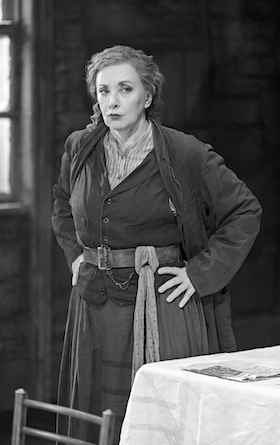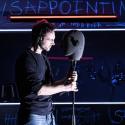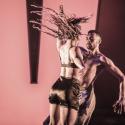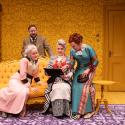"Captain" Jack Boyle is a fantasist, a mythmaker, a storyteller. He relishes an audience – usually his sidekick, Joxer. There is a theatricality in his part as written by O'Casey, but in Matthew Warchus's hands this is made an explicit element of the whole production, culminating in the unexpected finale. When the first scene opens, swags of red stage curtains rise and remain looped in place throughout, framing the action.
The play, the second in Seán O'Casey's Dublin trilogy, is set in the city in 1922. Citizens ground down by poverty suffer further as society is ripped apart by civil war when the IRA splits murderously. The Boyle family, like many others, is reduced to making do on very little in a cramped tenement, one of the flats into which grand houses had been divided when the better-off fled the city. Juno, wife, mother and breadwinner, lives up to her nickname as a heroic protector and provider. J Smith-Cameron (pictured below, right), known mainly in the UK for her role as straight-talking Gerri Kellman in Succession, is a respected stage actor who has previously played Juno to acclaim in New York. Here she is a slight, stoical figure, speaking fast, desperately attempting to cope, to get on top of things. Her weariness with her husband's fecklessness is apparent yet, when things are going well – which they do for a short period when the family seem to be the beneficiaries of a will – she can dance forgivingly with the wastrel "Captain" and enjoy a raucous party.
Mark Rylance makes the most of Boyle's narcissism and craving for recognition. He has never been the "Captain" of his adopted title, having only once sailed to Liverpool, but he can act the part, swaggering about town like a "paycock", deluding even himself with tales of his heroism in the battle of O'Connell Street, and making attempts at profound philosophising: "What is the stars" he muses drunkenly. Whenever the chance of work is mentioned, his play-acting becomes farcical as he doubles up with "pain" in his legs. In the first Act, Rylance's Boyle wickedly plays directly to the audience, shamelessly twinkling, drawing us in with a knowing side-eye. He and Paul Hilton's Joxer make a fine comic double act (Rylance sporting a Chaplinesque tash) as they josh, lie and tumble over each other like puppies to escape the ire of the long-suffering Juno.
Hilton's Joxer is not just the willing straight man to Boyle's strutting performer, but wily, intelligent, crafty. Neither exhibits any loyalty to the other beyond sharing drinking time. Either might betray the other at any moment and Warchus ensures that betrayal as a theme – of a colleague in arms (of which Johnny is guilty) or a lover (Juno's daughter Mary is abandoned when pregnant) – comes through clearly.
 There is poetry in O'Casey's rhythms as well as quotations from poets and some sweet traditional singing – nicely done by Rylance, Smith-Cameron and Aisling Kearns as Mary. And Anna Healy as blousy neighbour Mrs Madigan nearly stopped the show with her ear-rending top note during the short-lived partying. The Irish lilt is relatively muted: this is not escapism, less about the craic, more about cracks in society, family and politics. O'Casey labelled the play "a tragedy". While the first half of this production has the feel of knockabout music hall, the second lives up to that name – with an admixture of melodrama.
There is poetry in O'Casey's rhythms as well as quotations from poets and some sweet traditional singing – nicely done by Rylance, Smith-Cameron and Aisling Kearns as Mary. And Anna Healy as blousy neighbour Mrs Madigan nearly stopped the show with her ear-rending top note during the short-lived partying. The Irish lilt is relatively muted: this is not escapism, less about the craic, more about cracks in society, family and politics. O'Casey labelled the play "a tragedy". While the first half of this production has the feel of knockabout music hall, the second lives up to that name – with an admixture of melodrama.
O'Casey never wholly adopted naturalism and here it goes out of the tenement window completely. Rob Howell's set shows a partial down-at-heel interior, its walls jaggedly revealing other sketched-in tenements. In the final scene things literally fall apart and an enormous pietà looms over the broken remains of the Boyle family's home, their very lives shattered.
Priests remain offstage, but the power of Catholicism is ever-present in symbols and the characters' language. Young Johnny Boyle, injured in the fighting, is terrified that if the votive light goes out before the Virgin, his life too will end. For some reason, this focal point is replaced here by a hanging crucifix with no flickering light to symbolise the instability of Johnny's existence. The pietà – Christ's dead body being cradled by his mother – presses home Juno's tragedy: it is revealed when she has just left to identify her son's body. Often sacred music can be heard in the background, at odds with the brutality of the situation.
Then, in the final moments, Warchus introduces a major, unwelcome innovation. The text has Boyle and Joxer returning to their old ways, drunkenly announcing the world to be in "a state of chassis" while unaware that reality is about to strike them even more forcefully. If this seems to some too light-hearted a note on which to end, there is another possibility, the opportunity to focus on the poignancy of the weak, time-wasting men unknowingly abandoned to their fate, ignorant of Johnny's death and Juno's departure. Instead, Boyle drunkenly wields a gun with terrible consequences, carelessly bringing the violence of the outside into the remains of his home. This seems to me an artificial, unnecessary addition: O'Casey specifically avoided showing Johnny's execution after all.
The final image of the blasted home is perhaps designed to suggest current sites of devastation in Gaza and elsewhere. There is no need to make explicit any modern parallels: the poor are so often caught in crossfire around the world. O'Casey's Juno still speaks to us.
This is an unusual revival, giving both the comedy and tragedy full scope, but in the final scene it topples off balance into melodrama and becomes a different play altogether.















Add comment